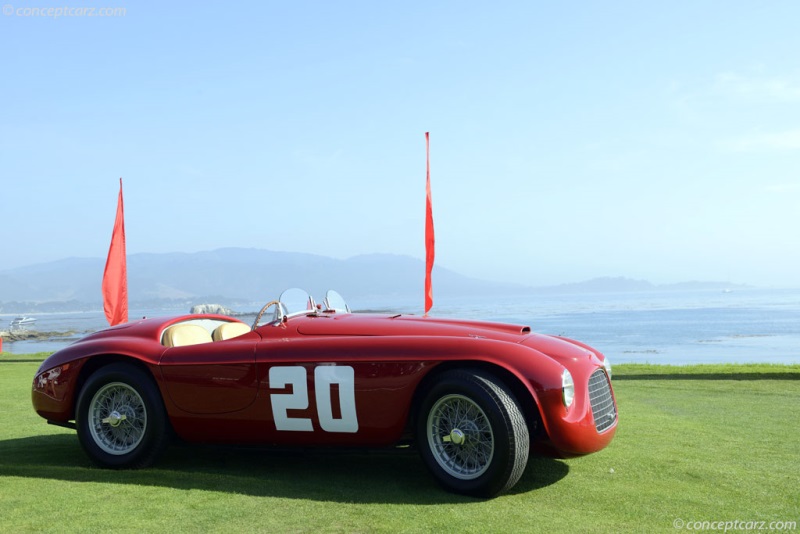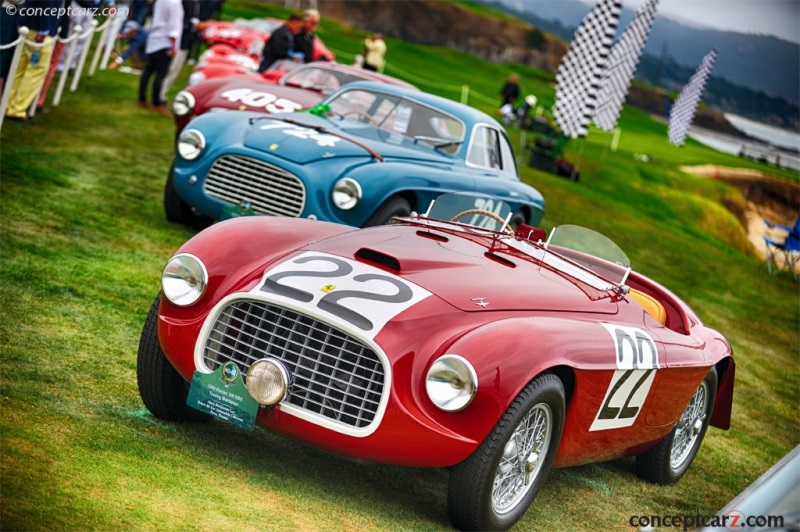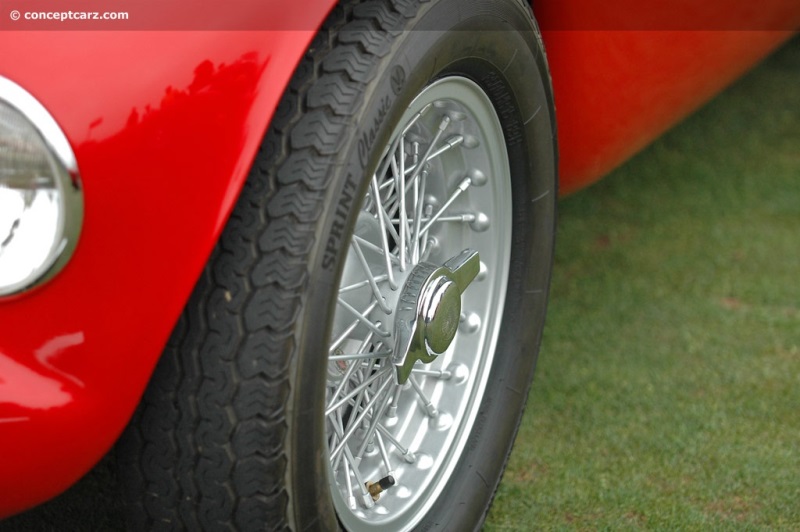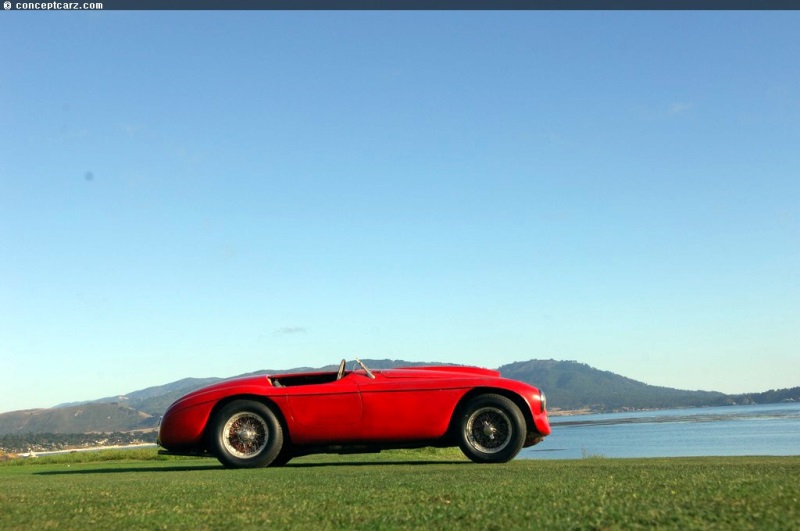The versatility of the Ferrari 166 was demonstrated by its illustrious career in motorsport and its allure as a road-going vehicle, blurring the distinction between racer and road car. It was the definitive sports car of its era, with simple, yet attractive coachwork accentuated by its smooth envelope, long flowing hood, and short tail earning it the nickname Barchetta or 'little boat.' 
Barchetta by Touring
Chassis #: 0052M
View info and historyEnzo Ferrari
Before the formation of the Ferrari marque in the immediate post-War era, Enzo Anselmo Giuseppe Maria Ferrari had unsuccessfully volunteered his services to Fiat in Turin, eventually settling for a job as test driver for C.M.N. (Costruzioni Meccaniche Nazionali), a car manufacturer in Milan. He made his competition debut as a race car driver in the 1919 Parma-Poggio di Berceto Hillclimb race, where he finished fourth in the three-liter category driving a 2.3-liter four-cylinder C.M.N. 15/20. He placed 9th in the 1919 Targa Florio (even though he retired early) and joined the racing department of Alfa Romeo as a driver in 1920. His first victory in a Grand Prix event was in 1923 in Ravenna on the Savio Circuit. The following year, he placed first at Ravenna, Polesine, and the Coppa Acerbo in Pescara. Despite his success, he was well aware of the dangers and was constantly reminded of the consequences, including the death of Ugo Sivocci in 1923 and Antonio Ascari in 1925. With the birth of his son Alfredo (Dino) in 1932, Ferrari traded his position behind the steering wheel with one behind a desk, focusing instead on the management and development of the factory Alfa race cars. He ended his driving career with 41 Grand Prix starts and 11 victories.Scuderia Ferrari was founded by Enzo in 1929 and served as the racing division of Alfa Romeo. Among their list of drivers included Tazio Nuvolari and Giuseppe Campari who complimented the sophisticated machines being built by Alfa Romeo under the direction of engineer Vittorio Jano. Despite a dominant contingent of German-built race cars from Auto Union and Mercedes, Scuderia Ferrari performed admirably, with numerous victories including at the German Grand Prix in 1935. Scuderia Ferrari's involvement with Alfa Romeo continued through 1937 when Alfa Romeo brought their racing program 'in-house' under the umbrella of the newly formed Alfa Corse. Enzo became the Sporting Director but left in 1939 following a disagreement with Alfa's managing director Ugo Gobbato. His contract clause restricted him from designing cars or racing for four years, so Enzo went a different route. With nearly two decades in the motorsports arena, Enzo founded Auto-Avio Costruzioni in 1939, supplying parts to racing teams. He did build two cars (the Tipo 815 based on a Fiat platform) for the 1940 Mille Miglia, despite the clause, which was piloted by Alberto Ascari and Lotario Rangoni. Ferrari S.p.A.
Auto Avio Costruzioni was headquartered in the facilities previously occupied by Scuderia Ferrari. In 1943, Enzo relocated to a factory in Maranello which was later bombed by the Allies during World War II and subsequently rebuilt. The first car to wear the Ferrari name was the 125 S of 1947. Ferrari 125 S
The 815 built by Enzo in the pre-WWII era was equipped with an inline-8 cylinder engine built from Fiat components and although it wore the Prancing Horse badge, it did not wear the Ferrari name. The 125 S received an Aurelio Lampredi-designed steel tube-frame chassis (with a 2420mm wheelbase size) built by Gilco, hydraulic power drum brakes all round, and a suspension comprised of double wishbones and transverse leaf springs. The front-mounted twelve-cylinder engine was designed by Gioacchino Colombo with a bore of 55mm and a stroke of 52.5mm, resulting in a 1,497cc (1.5-liter) displacement size. Colombo remained briefly with Ferrari, returning to Alfa Romeo shortly after having created the drawings. The engine used a single overhead camshaft design with two valves per cylinder, three double-choke Weber 30DCF carburetors, a 9.5:1 compression ratio, and developed 118 horsepower at 6,800 RPM. It was backed by a five-speed manual transmission mounted in-block with the engine instead of the traditional four-speed unit, as it was better suited to handle the power produced from the high revving V-12 engine.
Barchetta by Touring
Chassis #: 0052M
View info and historyFranco Cortese drove the 125 S at its racing debut at the Circuito di Piacenza in 1947. It failed to finish, but two weeks later, it earned Ferrari its first victory at the Grand Prix of Rome on the Terme di Caracalla Circuit, again driven by Cortese. Of the fourteen races that the 125 S contested during the 1947 season, it was victorious on six occasions. Ferrari 195 S
The bore and stroke of the 1.5-liter engine were increased to 59mm and 58mm, respectively, resulting in a 1,903cc (1.8-liter) displacement size and birthing the 195 S. It produced 125 horsepower at 6,500 RPM and had a compression ratio of 8.5:1, slightly less than that of its predecessor. The previous 30DCF carburetors were replaced by three Weber 32DCF units. A total of two examples of the 159S were built, with one later upgraded to 166 Spyder Corsa configuration. Both the 125 S and the 195 S had racing debuts in 1947, with the 195 S's first appearance also being the Circuito di Pescara on August 15th of 1947. Driven by Franco Cortese, it placed second overall after having led for part of the race. Its first victory was at the Turin Grand Prix that year where it had been driven by Raymond Sommer. The Ferrari 166 - S, Spyder Corsa, Inter, MM, and MM/53
Enzo Ferrari's legacy as a driver and racing director had been firmly established before the creation of Ferrari S.p.A., but it was the 166 which would establish Enzo's Modenese workshop as a leading racing car builder and defined many of the characteristics endowed upon future Ferrari cars. The 125 S, 195 S, and even the early 166 Sport and Spider Corsas would bring victory to the Ferrari marque, but it was the 166 Mille Miglia - or MM - which cemented the factory in the history books as a dominant sports car, winning all three of the great European sports car races including the Mille Miglia, the Targa Florio, and the 24 Hours of Le Mans.
Barchetta by Touring
Chassis #: 0010M
View info and historyThe formula endowed upon the 166 used many of the ingredients used on the previous Ferraris, including the Aurelio Lampred-designed tube frame, the 2420mm wheelbase (the MM used a shorter 2200mm platform), drum brakes, a double-wishbone/live axle suspension, and the Gioacchino Colombo-designed V12 engine. The bore and stroke increased to 60 by 58.8mm, respectively, resulting in a displacement of 1,995cc (2.0 liters). The '166' in the model designation referred to the swept volume of a single cylinder in cubic centimeters, with all 12 adding up to 1,992 cc, or nearly two liters. Output ranged from 110 PS to 140 PS depending on the configuration and carburetor setup. The displacement size made it eligible for the popular under 2-liter sports racing category in Italy. The Turin winner cycle fender 159 (serial number 002C) was upgraded to 166 specifications near the close of 1947 and renamed the 166 Spyder Corsa. Seven additional cars were constructed in 1948, with two 166 S models wearing coachwork by Carrozzeria Allemano and the final example by Carlo Anderloni at Carrozzeria Touring. Serial numbers and specifications were regularly changed during this era, so definitive lineage is hard to determine. It is believed that 002C is the oldest surviving Ferrari, and that 01C became 010I (a 125 S currently wearing a 125 S replica body built by Michelotto in 1987) and 02C became 020I. It is believed that three Sport and nine Spyder Corsa of the 166 were built.166 MM
The 166 earned its 'MM' nametag from Ferrari's first victory in the Mille Miglia in 1948, driven by Clemente Biondetti, who repeated the feat the following year. Also in 1949, Luigi Chinetti won the Le Man's 24-hour endurance race, which was nearly a solo achievement, as he had driven 23.5 of the 24 hours himself. The car driven by Chinetti was owned by Lord Selsdon, who drove for a small portion of the race to comply with racing regulations.
Barchetta by Touring
Chassis #: 0020M
Engine #: 0018M
View info and historyComplimenting the 166 MM's sophisticated specifications was a lightweight and attractive body created by Touring. Before Pininfarina became Ferrari's preferred coachbuilder, it was Carrozzeria Touring, based in Milan and headed by Carlo Felice Bianchi Anderloni, who was most closely associated with the Prancing Horse marque. In all, 25 Barchettas using their 'Superleggera' design were built by Touring. Around 46 examples of the 166MM (and MM/53) in various body styles were built by various coachbuilders. Approximately thirty-four examples of the 166 MM were built in a first series through late 1955. An additional run of around 13 second-series cars was built with the 2-liter V-12 engine, with six wearing spider coachwork by Vignale featuring more rounded designs of Michelotti's original design. Distinguishable features included cut-away rear fenders for improved brake cooling, upward-cut front fenders, cut-down doors, and recessed headlamps. Styles and configurations varied as these were hand-built cars. As production of the 166 was coming to a close, some of the later-built cars received brakes, shock absorbers, water radiators, and gearboxes used in the 212 models. Depending on the intended purpose, some examples received a larger (100-liter, 117-liter) competition fuel tank with central filler, twin exhausts with minimal resonators, or rear axles from the 340 race car. Street versions often received single Zenith carburetors, while others used the competition package of three Weeber 32-mm DCF carburetors, and compression increased from 8:1 to 10.1. Some competition cars did not have odometers, and their gauges often included a large tachometer, oil pressure gauge, oil and water temperature gauges, and fuel pressure gauge. Some cars received the five-speed gearbox with no synchronizers as the first, second and third gears were 'short' for optimal acceleration, while the top two gears were 'tall' for better top speed. 166 Inter
At the Turin Show in November of 1948, Ferrari displayed a pair of racing and road variations of the 166 - the 166MM and 166 Inter, respectively. Between 1948 and 1950, Ferrari built thirty-seven examples of the 166 Inter, which received chassis numbers in the odd number road car sequence between 007 S and 0079 S. Coachwork varied depending on the intended use and owner specification, with coachwork provided by Vignale, Turin, Bertone, Ghia, Ansaloni, and Stabilimenti Farina. The most popular wore those of Carrozzeria Touring in styles similar to the 166 MM Barchetta, albeit on a longer wheelbase chassis.
Barchetta by Touring
Chassis #: 0010M
View info and historyThe mechanical specification of the 166 Inter followed closely that of the 166 MM, with a two-liter V-12 engine coupled to a five-speed gearbox driving through a rigid rear axle. The Inter engines typically had a twin distributor, coil ignition system, and a single twin-choke carburetor. A triple carburetor setup could be specified, increasing the standard output of 110 bhp at 6,000 RPM nearer to the circa-160 bhp produced by 'MM' variants. The front suspension relied on transverse leaf springs, Houdaille lever-type hydraulic shock absorbers, and wishbones. In the back were semi-elliptic leaf springs and similar Houdaille hydraulic shock absorbers. Hydraulic drum brakes provided the stopping power. Wire wheels or steel disc-type CABO road wheels were available, with both using Rudge-type splined hub, sometimes with a chrome hub cap on the disc wheels. The Inter was the only road-production Ferrari of this era offered with the steel disc-type wheels.The Colombo-designed Engine
The 60-degree V12 engine designed by Gioacchino Colombo and used by the first Ferrari vehicles would outlive its linear successor, the Lampredi V12. The Lampredi V12 became a real force for the company, earning numerous victories for the Ferrari marque, but it was the Colombo engine that powered Ferraris to the forefront of high-performance Gran Turismo driving during the 1950s and 1960s. The last Lampredi engine was made in 1959 while the Colombo unit continued through 1988. The Colombo engine gained a 'second life' in 1952 when it powered the 250S, eventually powering the 250 Series which lasted through the 330 America of 1963. This included the 250 TR (Testa Rossa), 250 GT SWB, 250 GT TdF, and the 250 GT Series II. Over its production lifespan, the spark plugs were relocated to the outside of the cylinder head, allowing separate individual intake ports to use with the six two-barrel Weber carburetors. Dual overhead camshafts arrived in 1967 with the 275 GTB/4, however, they continued to use two valves per cylinder. Some versions used a Roots-type supercharger, dry or wet-sump lubrication, a more-compact 54-degree valve angle, and more. Displacement reached its pinnacle with the 400 and 412, with 4,823cc and 4,943cc, respectively. Carburetors were replaced with Bosch K-Jetronic fuel injection in 1979. Before the Colombo-designed engine was replaced, its bore measured 82mm and its stroke of 78 mm, a dramatic increase from the 60mm bore and 58.8mm stroke it was given in 1947.
by Daniel Vaughan | Mar 2022
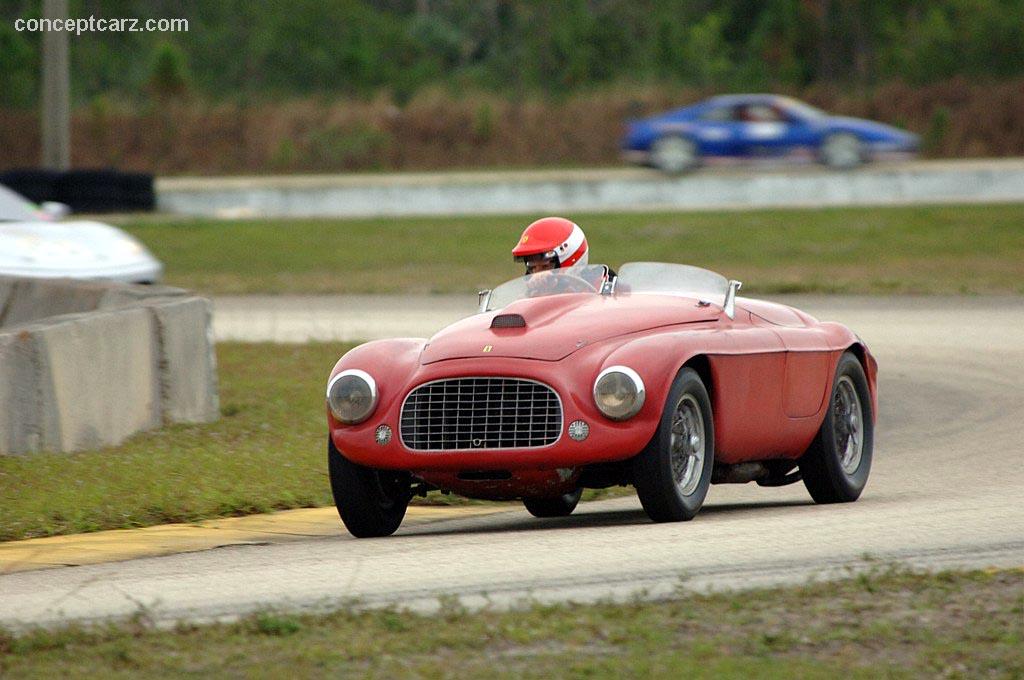
Barchetta by Touring
Chassis #: 0052M
View info and history
Before the formation of the Ferrari marque in the immediate post-War era, Enzo Anselmo Giuseppe Maria Ferrari had unsuccessfully volunteered his services to Fiat in Turin, eventually settling for a job as test driver for C.M.N. (Costruzioni Meccaniche Nazionali), a car manufacturer in Milan. He made his competition debut as a race car driver in the 1919 Parma-Poggio di Berceto Hillclimb race, where he finished fourth in the three-liter category driving a 2.3-liter four-cylinder C.M.N. 15/20. He placed 9th in the 1919 Targa Florio (even though he retired early) and joined the racing department of Alfa Romeo as a driver in 1920. His first victory in a Grand Prix event was in 1923 in Ravenna on the Savio Circuit. The following year, he placed first at Ravenna, Polesine, and the Coppa Acerbo in Pescara. Despite his success, he was well aware of the dangers and was constantly reminded of the consequences, including the death of Ugo Sivocci in 1923 and Antonio Ascari in 1925. With the birth of his son Alfredo (Dino) in 1932, Ferrari traded his position behind the steering wheel with one behind a desk, focusing instead on the management and development of the factory Alfa race cars. He ended his driving career with 41 Grand Prix starts and 11 victories.Scuderia Ferrari was founded by Enzo in 1929 and served as the racing division of Alfa Romeo. Among their list of drivers included Tazio Nuvolari and Giuseppe Campari who complimented the sophisticated machines being built by Alfa Romeo under the direction of engineer Vittorio Jano. Despite a dominant contingent of German-built race cars from Auto Union and Mercedes, Scuderia Ferrari performed admirably, with numerous victories including at the German Grand Prix in 1935. Scuderia Ferrari's involvement with Alfa Romeo continued through 1937 when Alfa Romeo brought their racing program 'in-house' under the umbrella of the newly formed Alfa Corse. Enzo became the Sporting Director but left in 1939 following a disagreement with Alfa's managing director Ugo Gobbato. His contract clause restricted him from designing cars or racing for four years, so Enzo went a different route. With nearly two decades in the motorsports arena, Enzo founded Auto-Avio Costruzioni in 1939, supplying parts to racing teams. He did build two cars (the Tipo 815 based on a Fiat platform) for the 1940 Mille Miglia, despite the clause, which was piloted by Alberto Ascari and Lotario Rangoni. Ferrari S.p.A.
Auto Avio Costruzioni was headquartered in the facilities previously occupied by Scuderia Ferrari. In 1943, Enzo relocated to a factory in Maranello which was later bombed by the Allies during World War II and subsequently rebuilt. The first car to wear the Ferrari name was the 125 S of 1947. Ferrari 125 S
The 815 built by Enzo in the pre-WWII era was equipped with an inline-8 cylinder engine built from Fiat components and although it wore the Prancing Horse badge, it did not wear the Ferrari name. The 125 S received an Aurelio Lampredi-designed steel tube-frame chassis (with a 2420mm wheelbase size) built by Gilco, hydraulic power drum brakes all round, and a suspension comprised of double wishbones and transverse leaf springs. The front-mounted twelve-cylinder engine was designed by Gioacchino Colombo with a bore of 55mm and a stroke of 52.5mm, resulting in a 1,497cc (1.5-liter) displacement size. Colombo remained briefly with Ferrari, returning to Alfa Romeo shortly after having created the drawings. The engine used a single overhead camshaft design with two valves per cylinder, three double-choke Weber 30DCF carburetors, a 9.5:1 compression ratio, and developed 118 horsepower at 6,800 RPM. It was backed by a five-speed manual transmission mounted in-block with the engine instead of the traditional four-speed unit, as it was better suited to handle the power produced from the high revving V-12 engine.
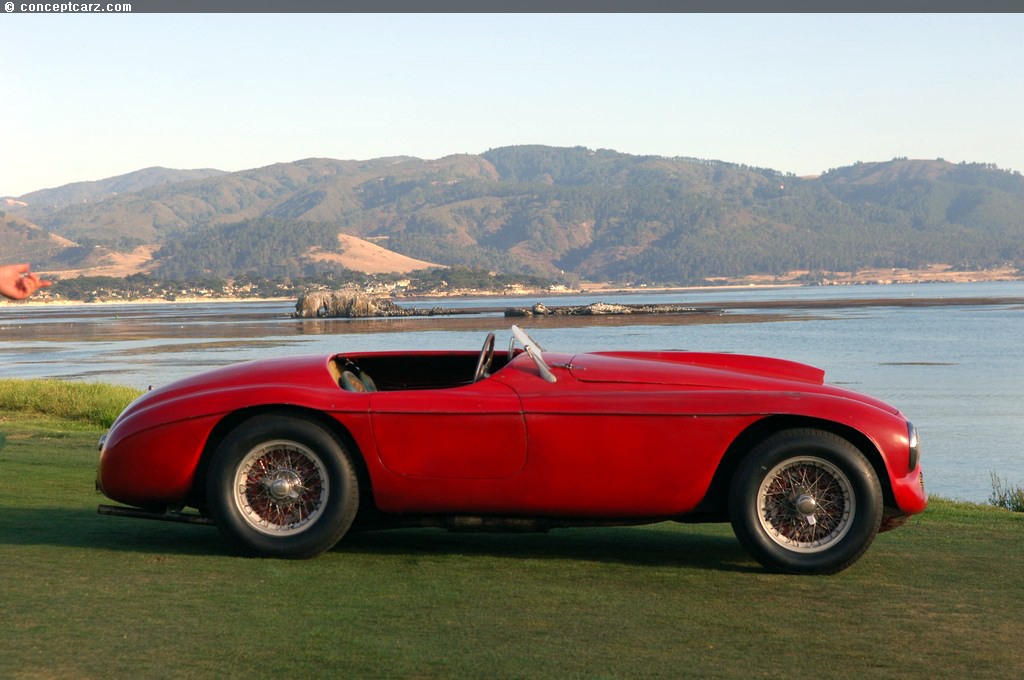
Barchetta by Touring
Chassis #: 0052M
View info and history
The bore and stroke of the 1.5-liter engine were increased to 59mm and 58mm, respectively, resulting in a 1,903cc (1.8-liter) displacement size and birthing the 195 S. It produced 125 horsepower at 6,500 RPM and had a compression ratio of 8.5:1, slightly less than that of its predecessor. The previous 30DCF carburetors were replaced by three Weber 32DCF units. A total of two examples of the 159S were built, with one later upgraded to 166 Spyder Corsa configuration. Both the 125 S and the 195 S had racing debuts in 1947, with the 195 S's first appearance also being the Circuito di Pescara on August 15th of 1947. Driven by Franco Cortese, it placed second overall after having led for part of the race. Its first victory was at the Turin Grand Prix that year where it had been driven by Raymond Sommer. The Ferrari 166 - S, Spyder Corsa, Inter, MM, and MM/53
Enzo Ferrari's legacy as a driver and racing director had been firmly established before the creation of Ferrari S.p.A., but it was the 166 which would establish Enzo's Modenese workshop as a leading racing car builder and defined many of the characteristics endowed upon future Ferrari cars. The 125 S, 195 S, and even the early 166 Sport and Spider Corsas would bring victory to the Ferrari marque, but it was the 166 Mille Miglia - or MM - which cemented the factory in the history books as a dominant sports car, winning all three of the great European sports car races including the Mille Miglia, the Targa Florio, and the 24 Hours of Le Mans.

Barchetta by Touring
Chassis #: 0010M
View info and history
The 166 earned its 'MM' nametag from Ferrari's first victory in the Mille Miglia in 1948, driven by Clemente Biondetti, who repeated the feat the following year. Also in 1949, Luigi Chinetti won the Le Man's 24-hour endurance race, which was nearly a solo achievement, as he had driven 23.5 of the 24 hours himself. The car driven by Chinetti was owned by Lord Selsdon, who drove for a small portion of the race to comply with racing regulations.
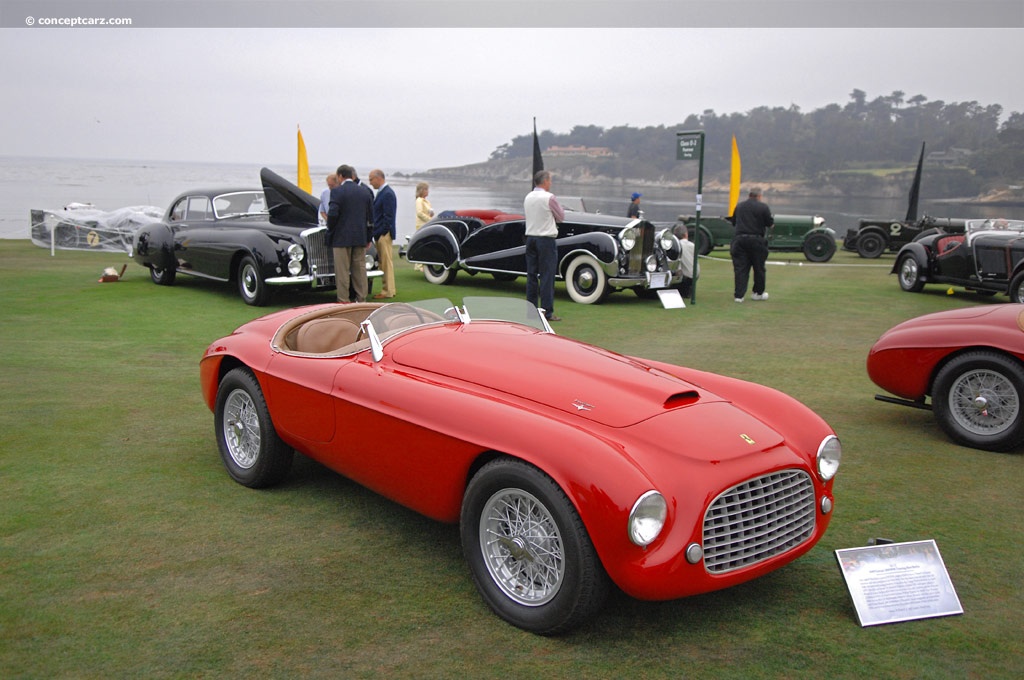
Barchetta by Touring
Chassis #: 0020M
Engine #: 0018M
View info and history
At the Turin Show in November of 1948, Ferrari displayed a pair of racing and road variations of the 166 - the 166MM and 166 Inter, respectively. Between 1948 and 1950, Ferrari built thirty-seven examples of the 166 Inter, which received chassis numbers in the odd number road car sequence between 007 S and 0079 S. Coachwork varied depending on the intended use and owner specification, with coachwork provided by Vignale, Turin, Bertone, Ghia, Ansaloni, and Stabilimenti Farina. The most popular wore those of Carrozzeria Touring in styles similar to the 166 MM Barchetta, albeit on a longer wheelbase chassis.
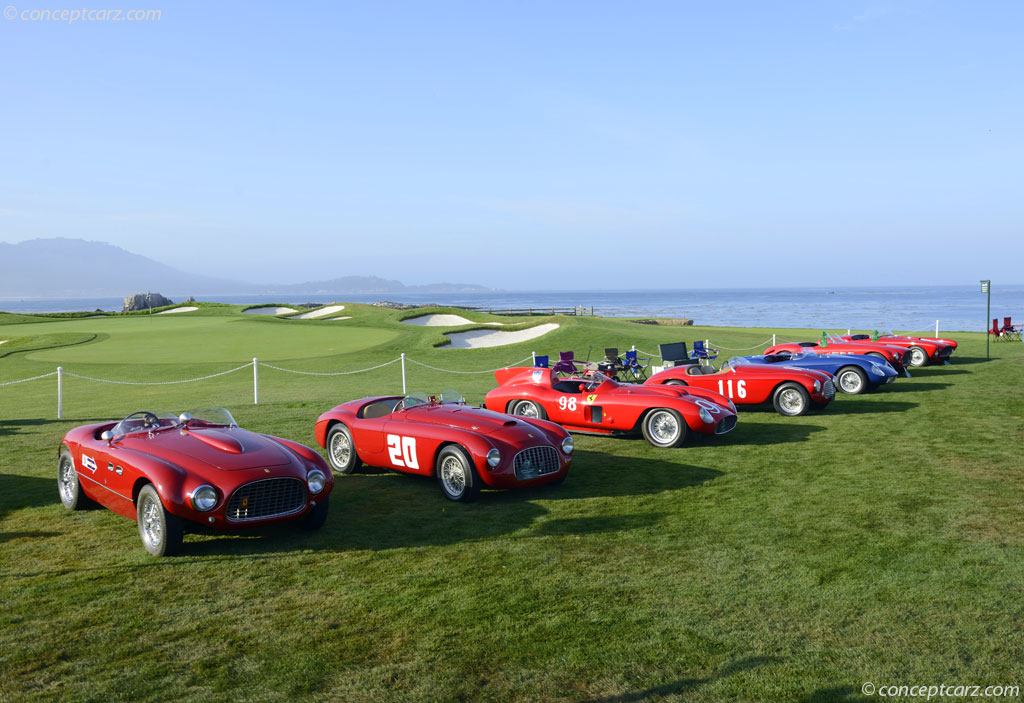
Barchetta by Touring
Chassis #: 0010M
View info and history
The 60-degree V12 engine designed by Gioacchino Colombo and used by the first Ferrari vehicles would outlive its linear successor, the Lampredi V12. The Lampredi V12 became a real force for the company, earning numerous victories for the Ferrari marque, but it was the Colombo engine that powered Ferraris to the forefront of high-performance Gran Turismo driving during the 1950s and 1960s. The last Lampredi engine was made in 1959 while the Colombo unit continued through 1988. The Colombo engine gained a 'second life' in 1952 when it powered the 250S, eventually powering the 250 Series which lasted through the 330 America of 1963. This included the 250 TR (Testa Rossa), 250 GT SWB, 250 GT TdF, and the 250 GT Series II. Over its production lifespan, the spark plugs were relocated to the outside of the cylinder head, allowing separate individual intake ports to use with the six two-barrel Weber carburetors. Dual overhead camshafts arrived in 1967 with the 275 GTB/4, however, they continued to use two valves per cylinder. Some versions used a Roots-type supercharger, dry or wet-sump lubrication, a more-compact 54-degree valve angle, and more. Displacement reached its pinnacle with the 400 and 412, with 4,823cc and 4,943cc, respectively. Carburetors were replaced with Bosch K-Jetronic fuel injection in 1979. Before the Colombo-designed engine was replaced, its bore measured 82mm and its stroke of 78 mm, a dramatic increase from the 60mm bore and 58.8mm stroke it was given in 1947.
by Daniel Vaughan | Mar 2022
Related Reading : Ferrari 166 History
Clemente Biondetti and Count Igor Troubetzkoy won the Targa Florio on April 3rd of 1948, marking Ferraris first major international win. The car was a closed Berlinetta Ferrari 166 and would later capture a victory at Italys most important race, the Mille Miglia in 1948. The Ferrari 166 was officially introduced at the Turin Salon in September of 1948. The body was courtesy of Touring utilizing....
Continue Reading >>
Continue Reading >>
Related Reading : Ferrari 166 History
It was in 1948 when the newly formed Italian automobile company named Ferrari began selling a promising sports car named the 166. The two-seater sports car featured a 12-cylinder engine mounted in the front and supplying over 100 horsepower to the rear wheels. The engine was just under two-liters in size and had a unitary displacement of 166 cc, thus, the evolution of the model name. Production would....
Continue Reading >>
Continue Reading >>
Similar Vehicles
Similar Automakers
Similarly Sized Vehicles
from 1949
1949 Ferrari 166 MM Vehicle Profiles
Recent Vehicle Additions
Performance and Specification Comparison
166 Specification Comparison by Year
Year
Production
Wheelbase
Engine
Prices
Related Automotive News

The Most Significant Ferrari In The World Joins The 166MM Celebration At Concours Of Elegance
The most significant Ferrari in the world, a 166MM Barchetta victorious at both the 1949 Mille Miglia and Le Mans 24 Hours, will be the highlight of a 166 celebration at Concours of Elegance
Set to feature at Hampton Court Palace from 6-8th Septemb...

Pebble Beach Auctions Online Catalogue Now Live; Historic, Unrestored 1962 Ferrari 250 GT SWB Berlinetta Unveiled as Headlining Car
Gooding %26 Company launches its entire online catalogue for the Pebble Beach Auctions, announces a remarkably original 1962 Ferrari 250 GT SWB Berlinetta along major Italian star cars.
Gooding %26 Company, the official auction house of the Pebble...

Ferrari Museum Celebrates Scuderia Ferrari's Landmark Anniversary With The '90 Years Exhibition'
Hypercars the story of Ferraris technological evolution told through milestone cars
Maranello, xx May 2019 – One of the great iconic names in motorsport with the power to unite an entire country and millions of fans from all over the...

Ferrari: Under The Skin
15 November 2017 - 15 April 2018
Major exhibition announced by the Design Museum in London to mark the 70th anniversary of Ferrari
£140M worth of Ferraris featured in exhibition displaying cars driven by racing drivers Peter Collins and Stir...
1956 Argentine Grand Prix: Least in the Kingdom is Greater
Speaking of the power of humility, the Bible says the least, within the context of the world, if they follow Gods commands, shall be greater than those considered great.
To say that Luigi Musso was the least within the kingdom of Scuderia Ferrari...

Historic Jaguar D-Type Leads Growing List of Significant Entries for RM's Monterey Sale
RM Auctions building towards a spectacular roster of cars for its flagship Monterey sale held during the famous Pebble Beach Concours dElegance motoring week, August 16–17, in California
Historic 1955 Jaguar D-Type leads a superb roster of the...






























